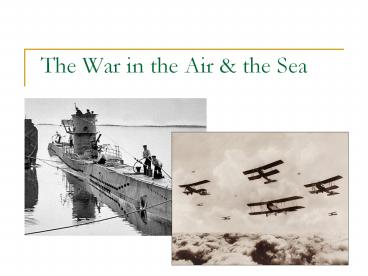The War in the Air - PowerPoint PPT Presentation
Title:
The War in the Air
Description:
The War in the Air & the Sea The War in the Air 1914: airplane is new and an unproven invention (military leaders didn t really have confidence in it) Canada had no ... – PowerPoint PPT presentation
Number of Views:293
Avg rating:3.0/5.0
Title: The War in the Air
1
The War in the Air the Sea
2
The War in the Air
- 1914 airplane is new and an unproven invention
(military leaders didnt really have confidence
in it) - Canada had no air force of its own, so any CDNs
who wanted to fly had to join the British Royal
Flying Corps - Trench warfare was known for being awful, and not
at all glorious, so young men flocked to be part
of the War in the Air.
3
Early Airplanes
- Max. speed between 95 and 125 km/h
- Airborne for 1 hour without needing to refuel
- First used to only scout for enemy positions.
- Pilots would carry a pistol others carried
bricks or chains?
4
Other Air Vehicles
- Germany had about 400 aircraft
- French 156 British 113
- Germans also developed a new plane (Fokker) that
only had one set of wings. - Armed with machine gun and a firing mechanism
timed so that the bullets did not hit the planes
own propeller blades. - Germans also used Zeppelin dirigibles or airships
for observation missions or bombing raids. (The
Allies eventually used them too.)
5
Allies Airplane Development
- By 1917, the Allies had developed the Sopwith
Camel, a fighter plane. - Fighting technique engage in aerial dogfights
(duels), manoeuvre their lighter planes to dive
on the enemy from the rear.
6
The Life of a Pilot
- Received better food and pay
- Wore better-looking uniforms
- Slept in warm beds at night
- Percentage killed was higher than in any other
branch of the military - In late 1916, it was said that the average
lifespan of a pilot was 3 weeks. - No parachutes
- Half of the casualties were due to mechanical
failure. - Ace a pilot who has shot down at least 5 enemy
planes
7
Famous Aces
- Red Baron
- Germanys Manfred von Richtofen
- Shot down 80 planes in his career
- Taken out by a Canadian in April 1918
8
Canadian Ace Capt. Roy Brown
- The Baron spotted an Allied plane below and went
after it. - His target was an inexperienced pilot, Wilfred
May. Mays gun was jammed. - Behind the Baron came Capt. Roy Brown, who opened
fire. - The Baron fell into a deadly spin, and died at
the age of 26.
9
Canadian Ace Billy Bishop
- As a boy growing up in Owen Sound, Bishop
practiced shooting at moving targets with his
rifle in the woods. - Made him one of the greatest pilots in the
British Commonwealth. - On his first day, he shot down a German plane.
- In one 5-day period, he shot down 13 planes.
10
Canadian Aces
- Canadian fighter pilots brought down 438 enemy
aircraft during WW1. - 4 of the top 7 leading aces of the Royal Air
Force - were Canadian.
11
The War at Sea
- Early May 1915, the British luxury liner
Lusitania was crossing the Atlantic Ocean. - The ship was unarmed and carried almost 2000
passengers. - Suddenly, a torpedo streaked through the waves
toward the full of the Lusitania. - Moments later, there was an explosion, panic,
chaos, and death. - 1198 people drowned at sea.
- Thus begins the use of the newest weapon at sea
the submarine.
12
German Submarines
- Prowling the seas since the beginning of the war.
- Downed 200 British ships by the end of 1914 and
warned that passenger ships would not be spared. - The Lusitania was different. More than half of
its passengers were American. (Talk about waking
a sleeping giant) - Germany knew that commanding the seas was
important to Britain, it being an island nation.
13
The German U-Boat
- Unterseeboot
- Early submarines could stay submerged for 2.5
hours, carrying a crew of 35 and 12 torpedoes. - Torpedoes could be shot underwater.
- U-boats preferred to come to the surface and
shoot at its targets with gunfire. - By 1916, German submarines were sinking an
average of 160 ships per month! - Germany predicted an early death for Britain.
14
The German U-Boat
- In 1917, Germany decided to take more drastic
action to defeat the Allies. - German navy introduced a new policy
unrestricted submarine warfare (sound
terrifying?) - German U-boats would sink any Allied or neutral
ship approaching Britain! - During the first 4 months of this operation,
Germany sank over 1000 British ships. - What were they going to do????
15
The Convoy System
- Cargo ships stopped sailing alone from Canada and
the US to Britain. - They sailed in fleets and were escorted by armed
destroyers, which watched for German U-boats. - German U-boats were incredibly successful, but
sinking the Lusitania eventually brought the US
into the war in 1917.
16
Canadian Contributions
- Providing sailors and ships for the Royal Navy
- Canadian shipyards built more than 60
anti-submarine ships and more than 500 smaller
anti-submarine motor launches. - Several thousand Canadians served in the British
Royal Navy, the Royal Naval Canadian Volunteer
Reserve, and in the Royal Naval Air Service.































